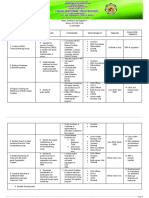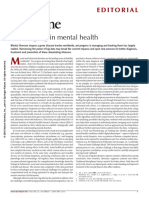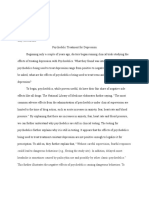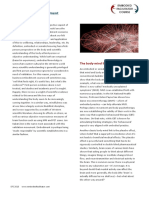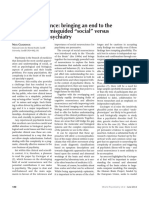Miller2012-Why Is Mental Ilness So Hard To Treat
Miller2012-Why Is Mental Ilness So Hard To Treat
Uploaded by
iulia andreeaCopyright:
Available Formats
Miller2012-Why Is Mental Ilness So Hard To Treat
Miller2012-Why Is Mental Ilness So Hard To Treat
Uploaded by
iulia andreeaOriginal Title
Copyright
Available Formats
Share this document
Did you find this document useful?
Is this content inappropriate?
Copyright:
Available Formats
Miller2012-Why Is Mental Ilness So Hard To Treat
Miller2012-Why Is Mental Ilness So Hard To Treat
Uploaded by
iulia andreeaCopyright:
Available Formats
NEWSFOCUS
Why Is Mental Illness So Hard to Treat?
“The last quarter century has seen many for- a major cause of disability throughout the Center for Psychiatric Research at the Broad
ward strides in the management of patients world. Why has it been so hard to develop Institute in Cambridge, Massachusetts, and
with mental disease. During this period new treatments? preceded Insel as NIMH director. In the
modes of therapy have been available that are “We just don’t know enough,” says “forced swim test,” for example, research-
far superior to the old-time method of whirl- Thomas Insel, director of the U.S. National ers put a rat or mouse in a tub of water and
ing patients on wheels or ducking them into Institute of Mental Health (NIMH) in clock how long it takes for the animal to
cold water.” So begins a 1954 article in the Bethesda, Maryland. “Research and stop struggling and just float, as if it’s given
Journal of the American Medical Association development in this area has been almost up. “This is called behavioral despair,”
on the calming effects of reserpine, a com- entirely dependent on the serendipitous dis- Hyman says. Of course, nobody knows if
pound derived from an Indian plant, on psy- coveries of medications. From the get-go, the rat experiences anything like what a per-
chotic patients in a California mental hospi- none of it was ever based on an understand- son in the grips of depression experiences,
tal. Its effects were so remarkable, the authors ing of the pathophysiology of any of the but rats given imipramine, one of the early
wrote, that if their findings held up, “reser- illnesses involved.” antidepressants, struggle longer. The forced
pine will be the most important therapeutic It’s little wonder that uncovering the roots swim test has in fact identified other drugs
Downloaded from www.sciencemag.org on October 6, 2012
development in the history of psychiatry.” of psychiatric illness has not been easy. Not that turn out to have antidepressant effects
Serious side effects ultimately prevented only is the brain the most complex organ in in humans, Hyman says, but by relying
reserpine from being the game changer its the body, but it’s also harder to study. Doc- on a test designed to find imipramine-like
early champions had envisioned, but other tors and researchers can’t biopsy a patient’s effects, researchers may have missed drugs
drugs discovered around the same time— brain as they would a diseased kidney or that work by means of other, potentially
including lithium for bipolar disorder, mono- swollen prostate. Genetic studies of psy- more effective mechanisms.
amine oxidase inhibitors for depression, and chiatric disorders may yet uncover solid Hyman, Insel, and others argue that too
chlorpromazine for schizophrenia—gave leads for drug developers, but so far they’ve much effort has been spent searching in
clinicians their first real weapons against mostly uncovered bewildering complexity. the narrow beam of light cast by the early
mental illness. There’s also the question of how well psychiatric drugs, looking for similar com-
Flash-forward to the 21st century. Cur- disorders of the human mind can be studied pounds or tweaking their chemistry to eke
rent psychiatric drugs are not much more in other species. Many of the animal models out improvements in efficacy, reduce their
effective than those initial medicines. of mental illnesses in use today were devel- side effects, and—not insignificantly—
Pharmaceutical companies have few prom- oped decades ago to screen for compounds preserve the revenue stream generated by
ising candidates in the pipeline and show with effects similar to those of the early patent-protected drugs. The field of psychi-
CREDIT: SUICIDE BY AMBER CHRISTIAN OSTERHOUT, CREATOR OF THE GAINING INSIGHT CAMPAIGN, WWW.GAINING-INSIGHT.COM
signs of giving up (Science, 30 July 2010, antidepressant and antipsychotic drugs, atric medicine, it seems, got lucky early on,
p. 502). Meanwhile, mental illness remains says Steven Hyman, who directs the Stanley and then it got in a rut.
However, several new tools and new ways
of thinking could help the field gain new
traction. One example, Insel says, comes
from drugs that target receptors for the neu-
rotransmitter glutamate, which recent evi-
dence suggests can reduce hopelessness and
suicidal ideation in people with depression
far faster than current drugs do. “That story,
while it’s still developing, is extraordinary
because it tells us we need to rethink our
expectations,” Insel says. “It may be possi-
ble to treat this in hours instead of weeks.”
Another encouraging inroad into
depression comes from deep brain stimu-
lation (DBS), in which surgeons implant
electrodes in brain regions thought to be
involved in regulating emotion and cogni-
tion. The approach is still experimental, and
only severely depressed patients who’ve
failed to respond to less invasive treat-
ments are eligible, but DBS seems to help
about three-quarters of them, says Helen
Mayberg, a neurologist at Emory University
in Atlanta and a pioneer of this therapy. The
success of DBS, Mayberg and others sug-
Don’t despair. Progress on new treatments for disorders of the mind has been frustratingly slow, but some gest, undermines the decades-old concept
researchers see new hope on the horizon. of mental illness as primarily a chemical
32 5 OCTOBER 2012 VOL 338 SCIENCE www.sciencemag.org
Published by AAAS
NEWSFOCUS
imbalance—too much or too little serotonin example, may involve mal- “Research and are some hints of con-
floating around the brain, for example—and functions in one network, development in this vergence: Many of the
points instead to faulty neural circuits as the while disordered think- autism risk genes appear
core problem. In their quest for the next gen- ing and other cognitive
area has been almost to be involved in com-
eration of treatments, researchers should problems involve another. entirely dependent mon biological functions,
focus less on single molecules and individ- This brain-based view is on the serendipitous such as synaptic signal-
ual brain regions, Mayberg says, and think at odds with the traditional ing and brain develop-
discoveries of
of the brain as “a dynamic system that has to approach of diagnosing ment. Researchers now
be properly choreographed.” disorders according to the medications.” have novel tools at their
One powerful new tool for examining behavioral problems and —THOMAS INSEL, disposal to follow up on
neural circuits at the cellular level is opto- inner anguish they cause— U.S. NATIONAL INSTITUTE these leads, including
genetics, which combines laser optics and the approach taken by psy- OF MENTAL HEALTH the ability to create neu-
genetic engineering to stimulate or inhibit chiatry’s go-to diagnostic rons from reprogrammed
specific classes of neurons in rodents and guide, the Diagnostic and stem cells from patients
monkeys. Researchers have employed opto- Statistical Manual of Mental Disorders (Science, 26 November 2010, p. 1172).
genetic methods in mice to investigate the (DSM), published by the American Psychiat- Gene expression prof iling—investigat-
mechanisms of DBS therapy for Parkinson’s ric Association. “There’s no doubt that these ing the activity of thousands of genes—in
Downloaded from www.sciencemag.org on October 6, 2012
disease (Science, 20 March 2009, p. 1554) categories [in the DSM] don’t map very well these human neurons could help research-
and to study the neural circuits involved in onto nature,” Carter says. An effort to create ers identify the biological pathways dis-
addiction, anxiety, and other conditions. a new diagnostic scheme rooted in biology, rupted by autism risk genes and screen drugs
On a larger scale, human brain imag- spearheaded by NIMH, is already under way to correct them, says Daniel Geschwind, a
ing research is illustrating that psychiatric (Science, 19 March 2010, p. 1437). neurogeneticist at UC Los Angeles. “I’m
conditions are multifaceted, with different And studies of the human genome may extremely optimistic that [by] using a com-
symptoms that can be traced to different net- yet lead to innovative drugs for mental ill- bination of these methods we’re going to be
works of brain regions, says Cameron Carter, ness. Researchers have identified hundreds developing new classes of drugs,” he says.
a cognitive neuroscientist at the University of genetic variants that increase the risk of “I think we’re on the threshold of something
of California (UC), Davis. The delusions autism, for example. Making sense of this really exciting.”
and hallucinations of schizophrenia, for deluge of new data is a challenge, but there –GREG MILLER
Why Are Our Brains So Big? brain were easy, one might think that every
animal would have one. Yet brains use a lot
of energy, and most species have maintained
With an average volume of about 1400 cubic scanning studies in humans and monkeys smaller ones throughout their evolution,
centimeters, the human brain is more than have found correlations between the size apparently avoiding the cost of fueling all
three times as large as that of the chimpanzee, of social networks and that of specific brain that processing power.
our closest living evolutionary cousin. And areas linked to sociality (Science, 4 November One key question is whether a species’
although the brains of whales and elephants 2011, p. 578). One study of people, for exam- group size, which is usually considered a
are bigger in absolute terms, once adjusted ple, found a positive relationship between proxy for its social complexity, was the driv-
for body weight the size of the Homo sapiens gray matter density and the number of Face- ing factor in the evolution of bigger brains, or
brain outstrips that of any other animal. book friends an individual has. if it was the other way around: Natural selec-
For the past 2 decades, the leading expla- “The social brain hypothesis is widely tion could have favored larger brains for other
nation for why natural selection bestowed accepted and has generated a huge amount reasons, such as greater innovation in food-
such generous largesse on the human nog- of research,” says Robert Seyfarth, a bio- foraging and tool-using skills, which then
gin has been the social brain hypothesis. logical anthropologist at the University made larger social groups possible.
The researcher with whom the idea is most of Pennsylvania. Yet there are competing Richard Byrne, a cognitive neuroscien-
closely associated, psychologist Robin explanations for our big brains, and Seyfarth tist at the University of St Andrews in the
Dunbar of the University of Oxford in the and other researchers are concerned that United Kingdom, argues that great apes
United Kingdom, has argued that brain Dunbar’s formulation may be too simplistic like chimps, gorillas, and humans evolved
size—and particularly the size of the brain’s to account for the complex course of human larger brains “to solve challenging food-
neocortex—most closely correlates with the brain evolution. The social brain hypothe- acquisition problems better than monkeys,”
size of a species’ social group. Keeping track sis “now needs to be balanced against other with whom they competed for resources in
of who is doing what to whom, Dunbar and complementary hypotheses and more fully the wild. His “Machiavellian intelligence”
other researchers argue, requires consider- integrated” with evidence from cognitive hypothesis, formulated in the late 1980s
able processing power, and so bigger groups neuroscience, says Robert Barton, an evo- with St Andrews colleague Andrew Whiten,
demand bigger brains. lutionary anthropologist at Durham Univer- focused on the cognitive challenges of bal-
Numerous studies by Dunbar and oth- sity in the United Kingdom. ancing competition and cooperation within
ers appear to support the link between a spe- Researchers generally agree that our large primate groups, and was a forerunner to the
cies’ group size and neocortex size, especially brains have something to do with how smart social brain hypothesis.
among primates (Science, 7 September 2007, we are and why we were able to take over the These challenges, Byrne says, led to brains
p. 1344). And recently, a number of brain- planet. But if the evolutionary path to a big better equipped to understand cause and
www.sciencemag.org SCIENCE VOL 338 5 OCTOBER 2012 33
Published by AAAS
You might also like
- Body Constellations Mind Body Spirit Root CausesDocument108 pagesBody Constellations Mind Body Spirit Root CausesKristin Murphy100% (1)
- Psycho Neuro ImmunologyDocument14 pagesPsycho Neuro ImmunologyWhisperer Bowen100% (1)
- Company Introduction Marketing Plan OfHCG & HMGDocument29 pagesCompany Introduction Marketing Plan OfHCG & HMGwk babar100% (2)
- Wins Action Plan 2019Document8 pagesWins Action Plan 2019Girlie Harical Gangawan100% (1)
- Double-X Nutrition Facts PDFDocument1 pageDouble-X Nutrition Facts PDFS.odysseyNo ratings yet
- SchizophreniaDocument28 pagesSchizophreniaofficialcchr0% (1)
- 2022-07 Morgan Stanley - PsychedelicsDocument8 pages2022-07 Morgan Stanley - PsychedelicsMyron BrandwineNo ratings yet
- HOW THE BRAIN CONTROLS SICKNESS AND HEALTHDocument3 pagesHOW THE BRAIN CONTROLS SICKNESS AND HEALTHSebastiánCandiaNo ratings yet
- Psychedelic TreatmentsDocument3 pagesPsychedelic TreatmentsPanagiotis MisthosNo ratings yet
- Advancing Preclinical Chronic Stress Models To Promote Therapeutic Discovery For Human Stress DisordersDocument12 pagesAdvancing Preclinical Chronic Stress Models To Promote Therapeutic Discovery For Human Stress DisordersMoo Gee100% (1)
- NeurogenesisDocument5 pagesNeurogenesisMike DonohueNo ratings yet
- On The Spectrum: FeatureDocument3 pagesOn The Spectrum: FeatureOana OrosNo ratings yet
- ADHD - Brain Problem Reduces Coping Skills in Kids With ADHD - 2008 - Crime Times PDFDocument8 pagesADHD - Brain Problem Reduces Coping Skills in Kids With ADHD - 2008 - Crime Times PDFCesar MartinNo ratings yet
- Postpartum DepressionDocument4 pagesPostpartum Depressionpajotak519No ratings yet
- NM 4471-2Document1 pageNM 4471-2alma.ac.labNo ratings yet
- Rogerian EssayDocument4 pagesRogerian Essayapi-653591630No ratings yet
- David Perlmutter, The Dynamic Brain: Presenters 2017Document6 pagesDavid Perlmutter, The Dynamic Brain: Presenters 2017carlos miñoNo ratings yet
- Doctors Newly Define Another Type of Dementia, Sometimes Mistaken For Alzheimer's - CNNDocument3 pagesDoctors Newly Define Another Type of Dementia, Sometimes Mistaken For Alzheimer's - CNNtellarolicaNo ratings yet
- How Evolutionary Psychiatry Can Advance PsychopharmacologyDocument9 pagesHow Evolutionary Psychiatry Can Advance PsychopharmacologydandanddingNo ratings yet
- Research SpotlightsDocument2 pagesResearch SpotlightsstanscimagNo ratings yet
- 5 Surprising Ways That Stress Affects Your Brain: More in TheoriesDocument5 pages5 Surprising Ways That Stress Affects Your Brain: More in TheoriesMuhdAisar96No ratings yet
- Chap 1-3Document14 pagesChap 1-3Kathryn DavidNo ratings yet
- NesseDocument2 pagesNesseralu18No ratings yet
- Collection of Quotes of Personal Experiences After Antipsychotic Drugs Most Specifically Risperidone and OlanzapineDocument31 pagesCollection of Quotes of Personal Experiences After Antipsychotic Drugs Most Specifically Risperidone and Olanzapinepat789963No ratings yet
- Cognition in Mood DisordersDocument3 pagesCognition in Mood DisordersAndreLeonorNo ratings yet
- Marijuana May Boost, Rather Than Dull, The Elderly BrainDocument9 pagesMarijuana May Boost, Rather Than Dull, The Elderly BrainJuan Razeto BarryNo ratings yet
- What Kind of Healing Does Psychedelic-Assisted Psychotherapy FosterDocument11 pagesWhat Kind of Healing Does Psychedelic-Assisted Psychotherapy FosterGlobal Research and Development ServicesNo ratings yet
- 12 Science of EmbodimentDocument5 pages12 Science of EmbodimentfelipeNo ratings yet
- Stroke of InsightDocument2 pagesStroke of Insightapi-407846283No ratings yet
- Our Understanding of Depression Is Changing. Why Isn't Treatment - Scientific AmericanDocument4 pagesOur Understanding of Depression Is Changing. Why Isn't Treatment - Scientific AmericanPatykNo ratings yet
- Scientificamerican1210 36Document2 pagesScientificamerican1210 36peter.tay.research5648No ratings yet
- Psychoneuroimmunology - Laugh and Be WellDocument9 pagesPsychoneuroimmunology - Laugh and Be Wellj2pcqjychcNo ratings yet
- Articulo Cappas, NMDocument10 pagesArticulo Cappas, NMJenniffer RiveraNo ratings yet
- Panic Disorder: A Common Yet Underdiagnosed and Misunderstood Psychological Illness in PakistanDocument3 pagesPanic Disorder: A Common Yet Underdiagnosed and Misunderstood Psychological Illness in PakistanSharii AritonangNo ratings yet
- What Is A Mood Stabilizer?: Psychological Medicine June 2007Document7 pagesWhat Is A Mood Stabilizer?: Psychological Medicine June 2007Yulia RestyNo ratings yet
- Cognitive Fitness ReadingDocument10 pagesCognitive Fitness Readinggamervidu25No ratings yet
- Manipulating Brain Activity To Boost Confidence: Science NewsDocument4 pagesManipulating Brain Activity To Boost Confidence: Science NewsJoeNo ratings yet
- Addiction and The Brain Development Not DiseaseDocument13 pagesAddiction and The Brain Development Not DiseaseGayneOrtegaNo ratings yet
- Introduction To Pschy - StudocDocument18 pagesIntroduction To Pschy - Studocarvie montemayorNo ratings yet
- Smart 2018Document3 pagesSmart 2018Bilel ChefiratNo ratings yet
- Consciousness Influences EpigeneticsDocument9 pagesConsciousness Influences Epigeneticscharchar290906No ratings yet
- Thought Field Therapy and Its Derivatives Rapid ReDocument6 pagesThought Field Therapy and Its Derivatives Rapid Refatemeh zandiNo ratings yet
- The Mental Revolution:: The Doorway To Your SubconsciousDocument3 pagesThe Mental Revolution:: The Doorway To Your SubconsciousJegzNo ratings yet
- Psychiatric Reports A Must For All PsychiatristsDocument6 pagesPsychiatric Reports A Must For All PsychiatristsdrdrilolajciNo ratings yet
- Birbaumer Et Al (2005)Document7 pagesBirbaumer Et Al (2005)Micaela TaverniniNo ratings yet
- Conrad Hyperkinesis 1975 PDFDocument11 pagesConrad Hyperkinesis 1975 PDFnoesnaturalNo ratings yet
- Bits & Pieces You Might've Missed About Your Sjogren Syndrome: The Cause and The Cure?From EverandBits & Pieces You Might've Missed About Your Sjogren Syndrome: The Cause and The Cure?Rating: 5 out of 5 stars5/5 (1)
- Craddock 2014 World PsychiatryDocument2 pagesCraddock 2014 World PsychiatryPrateekGandhiNo ratings yet
- How Psychedelic Drugs Can Be Used For Mental Health - The New York TimesDocument5 pagesHow Psychedelic Drugs Can Be Used For Mental Health - The New York TimesFernanda FernandesNo ratings yet
- Dont Stress About ItDocument3 pagesDont Stress About ItHan YiNo ratings yet
- Is Mysticism Becoming A Problem For Psychedelic Medicine?Document13 pagesIs Mysticism Becoming A Problem For Psychedelic Medicine?adrianrocchioNo ratings yet
- Don't Fret, NeuroticsDocument8 pagesDon't Fret, NeuroticsVictor Hugo Loaiza SeguraNo ratings yet
- What Are Antidepressants' Long-Term Effects?: Page 1 of 2Document2 pagesWhat Are Antidepressants' Long-Term Effects?: Page 1 of 2MadzekeNo ratings yet
- T D - D P T B D: HE Oman Elacato Atterning Reatment FOR Rain AmageDocument10 pagesT D - D P T B D: HE Oman Elacato Atterning Reatment FOR Rain AmageintannurfirdausiNo ratings yet
- Conrad - 1975 - The Discovery of Hyperkinesis - Society For The Study of Social ProblemsDocument11 pagesConrad - 1975 - The Discovery of Hyperkinesis - Society For The Study of Social ProblemsLais ArendNo ratings yet
- Drugs and Acupuncture: The Energetic Impact of Antidepressant MedicationsDocument7 pagesDrugs and Acupuncture: The Energetic Impact of Antidepressant Medicationspeter911x2134No ratings yet
- Woman Successfully Treated For Depression With Electrical Brain Implant - Depression - The GuardianDocument3 pagesWoman Successfully Treated For Depression With Electrical Brain Implant - Depression - The GuardianAlfonso El SabioNo ratings yet
- 2022-Sep-10 New Scientist - Figuring Out FatigueDocument5 pages2022-Sep-10 New Scientist - Figuring Out FatigueRyan HoangNo ratings yet
- Pill To Erase Bad MemoriesDocument2 pagesPill To Erase Bad MemoriesMark ZlomislicNo ratings yet
- Re InstitutionpaperDocument2 pagesRe Institutionpaperapi-319840185No ratings yet
- MedacademyDocument2 pagesMedacademyapi-484917863No ratings yet
- Drug Reverses Age-Related Cognitive Decline Within Days: Credit: CC0 Public DomainDocument4 pagesDrug Reverses Age-Related Cognitive Decline Within Days: Credit: CC0 Public DomainQuaxi1954No ratings yet
- Evidences of Possible Side Effects of Neurolepti 2012 Asian Pacific JournalDocument7 pagesEvidences of Possible Side Effects of Neurolepti 2012 Asian Pacific Journaly8tgqdfqkpNo ratings yet
- Pengaruh Senam Diabetes Terhadap Kadar Gula Darah Pada Pasien Diabetes Mellitus Tipe 2 Di Wilayah Puskesmas Periuk Jaya Kota TangerangDocument8 pagesPengaruh Senam Diabetes Terhadap Kadar Gula Darah Pada Pasien Diabetes Mellitus Tipe 2 Di Wilayah Puskesmas Periuk Jaya Kota TangerangfardhaniNo ratings yet
- Qaulity Improvement Manual DH AHMEDNAGARDocument56 pagesQaulity Improvement Manual DH AHMEDNAGARcs nagarNo ratings yet
- Haryana Municipal Act 1973 PDFDocument178 pagesHaryana Municipal Act 1973 PDFAmit AggarwalNo ratings yet
- Exercise 2Document3 pagesExercise 2sidratilbalqisNo ratings yet
- Artikel Ratna ApdDocument10 pagesArtikel Ratna ApdZulham EfendiNo ratings yet
- Catch Up Friday LP Light MARCH 1Document5 pagesCatch Up Friday LP Light MARCH 1Jolly Ann Dela PazNo ratings yet
- NRES-2-Course-Outline - Feb 2023Document9 pagesNRES-2-Course-Outline - Feb 2023jericho dinglasan100% (1)
- Full download Exercise Physiology; For Health and Sports Performance; Second Edition Nick Draper pdf docxDocument62 pagesFull download Exercise Physiology; For Health and Sports Performance; Second Edition Nick Draper pdf docxgreimdesco100% (3)
- 1-Co - Trimoxazol: AntibioticsDocument66 pages1-Co - Trimoxazol: Antibioticsmohamed mahmoudNo ratings yet
- 2024.01.30 Snap ComplaintDocument83 pages2024.01.30 Snap ComplaintJessica HillNo ratings yet
- Reading Parts 1-6Document12 pagesReading Parts 1-6truchateleNo ratings yet
- Wheel Chair TransfersDocument5 pagesWheel Chair TransfersLucioAsmatNo ratings yet
- Cesc Q3W2 Social Science Institutional and Civil Society PerspectivesDocument26 pagesCesc Q3W2 Social Science Institutional and Civil Society PerspectivesAkiraNo ratings yet
- Jurnal Media Keperawatan: Politeknik Kesehatan Makassar Vol. 12 No. 1 2021 E-Issn: 2087-0035Document6 pagesJurnal Media Keperawatan: Politeknik Kesehatan Makassar Vol. 12 No. 1 2021 E-Issn: 2087-0035Tuti NingsihNo ratings yet
- Symptom Mangement For Shortness of Breath/AnxietyDocument6 pagesSymptom Mangement For Shortness of Breath/AnxietySandra SalterNo ratings yet
- Global Food Systems From A Legal Perspective - Graduate Institute Geneva 2015Document8 pagesGlobal Food Systems From A Legal Perspective - Graduate Institute Geneva 2015MitchNo ratings yet
- Department of Obstetrics and Gynecology FinalDocument42 pagesDepartment of Obstetrics and Gynecology Finalkremlin23455No ratings yet
- Permit To Work 2022Document2 pagesPermit To Work 2022mwesigye franklynneNo ratings yet
- David Laid Dup Program - CompressDocument15 pagesDavid Laid Dup Program - CompressツLucahNo ratings yet
- Tooth-Colored RestorationsDocument6 pagesTooth-Colored Restorationsعمر ايمن مؤيدNo ratings yet
- 3 Risk AssessmentDocument31 pages3 Risk Assessmenta.pavloffskiyNo ratings yet
- Ludwig AnginaDocument14 pagesLudwig AnginaAnggri SeptyanNo ratings yet
- 9 Things Men Would Only Do When They're in Deep LoveDocument3 pages9 Things Men Would Only Do When They're in Deep LoveAmruth PnsNo ratings yet
- Paragon HDL Second Edition Quick-Start GuideDocument9 pagesParagon HDL Second Edition Quick-Start GuideDaniel KällgrenNo ratings yet
- List of PPN Hospitals in DelhiDocument4 pagesList of PPN Hospitals in DelhiIMRAN AHMADNo ratings yet
- Internship Report Niftem (1) FinalDocument62 pagesInternship Report Niftem (1) FinalSagar ShokeenNo ratings yet
- Intro To Political Analysis and Research - Presentation of DataDocument7 pagesIntro To Political Analysis and Research - Presentation of Databyun baek hyunNo ratings yet



